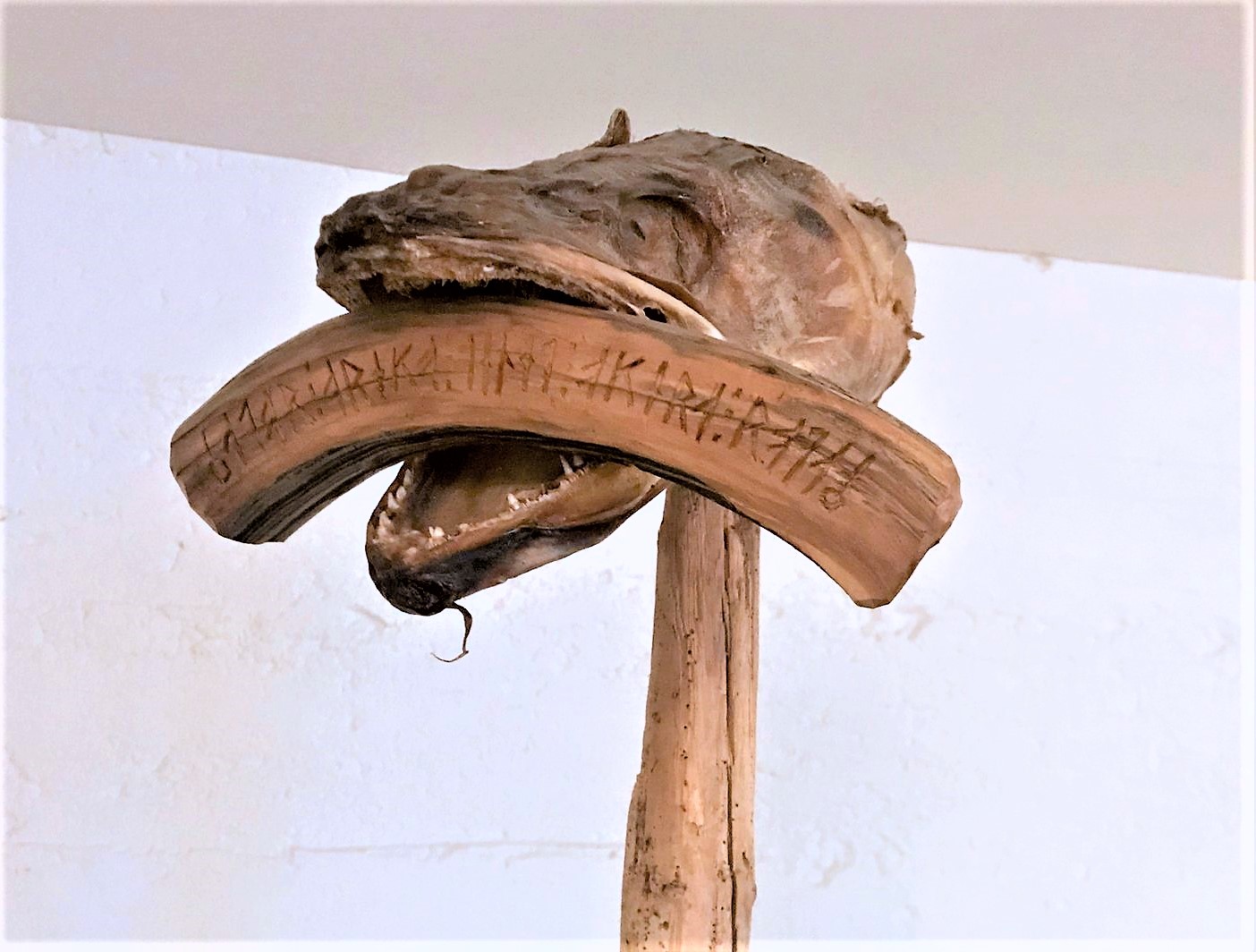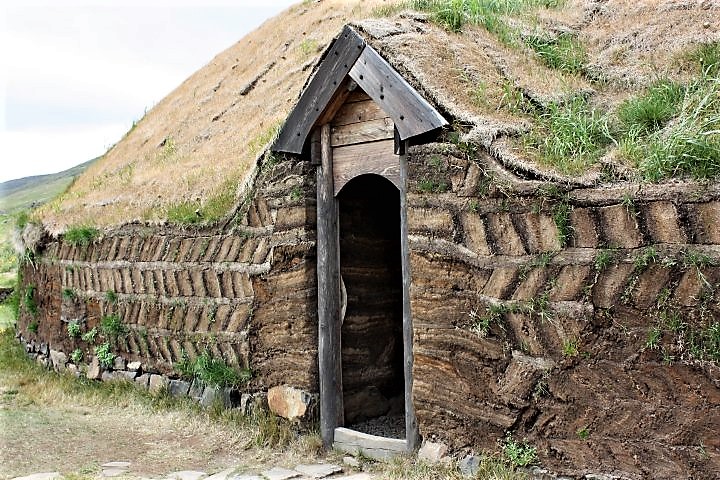The sorcerer
Up north lived a humble and a quiet sorcerer by the name of Torfi Sveinsson (1762-1843) or better known as Torfi úr Klúkum (Torfi of Klúka). He learned early on that magic is for the good of the common people and limited his abilities to help those in distress. Torfi was described as being very tall, very thin and hunched over with beautiful bright eyes.
Torfi was the son of reverend Sveinn Jónsson (1727-1804) from Tunga in Stýfla and Hólmfríður Þorláksdóttir (1731-1780) from Sjávarborg. His father was a skilled sorcerer and at an early age, Torfi saw the power witchcraft can have.

Power of magic
He was usually very reluctant to help others and was quite modest about his abilities. As people pressed him a little more, he usually caved in and agreed to help. One of his better talents as to find out what had happened to stolen items. Consequently, as soon as thieves knew Torfi was involved they gave themselves up right away. They'd rather admit to their crimes than be under Torfi's hex.
The search

As soon as he was of age, Torfi set out into the world to seek a deeper understanding of magic. He wasn’t sure where the best place to learn magic was, but hoped to figured it out along the way. On his travel, he stopped by Undir Jökli (Under the Glacier) where he attended a home school to study sorcery.
He excelled quickly as a student and his confidence in the arts grew. With the growing knowledge, he wanted nothing more than to write a book about magic. He had great penmanship and a beautiful handwriting which were great qualities for writing a book. It didn’t take him long to act on his desire and right away he began gathering material for a book. He was going to call it the new galdrakver (the new magic book). This was because there already was a book called galdrakver that was written in 1670 (mentioned in my post here).
Sorcerer in the big city

Torfi had heard about a Svartiskóli (Black School) in Reykjavík and continued his travels to the big city. Svartiskóli wasn’t exactly a school, but an area in Reykjavik that had acquired the nickname. Perhaps because there was such a school there? Eager to begin his studies, he headed straight for the school and found the Dean who was a sorcerer.
Torfi wanted to show everyone that magic is for the good of the common people. Despite his good intentions and great talent, the Dean refused to take him on as a student. The Dean feared that he’d become an even greater sorcerer than himself, just like Sæmundur the Wise before him.

Svartiskóli - The Black School
Svartiskóli (black school) was the name of a small area between Vesturgata and the ocean. I was unable to find a sorcerer's school in Reykjavík. There are no records of how or why its nickname, Svartiskóli so, maybe there was a school there that taught witchcraft.

Air view of Kvosin area
The orange mark in the photo shows today's location of Svartiskóli.

Svartiskóli today
One house still stands as a memory of this old neighborhood and is called Hlíðarhús. It stands in the midst of a modern apartment complex
Undeterred, Torfi stayed in the capitol to study on his own. He experimented with magic and became known as Iceland’s only healing sorcerer. Just like he feared, many city folks were against sorcery. This was exactly why he wanted to show that magic was for the good of the common people. Even so, people were spooked and he was forced to flee the city.
Heading north

Torfi kept writing his book, but was forced to head back north. He now had several years of research behind him which added great value to his material. Not only that but all the hardship and ill treatment he suffered affected his writings as well. By the time he got home his book was nearly finished, yet there was much more left to learn. There was on particular incident that he couldn’t stop thinking about.
While wandering the northern parts, he stopped at Ódáðahraun where he stayed most of the summer. During his stay, he got know gamla Marína (old Marína). She was a fortuneteller and one time when she looked at his cards she told him that he’d have his trousers stolen and suffer a frostbite on his big toe.

Ódáðahraun
Three mountains in the background: Sellandafjall (988m), Bláfjall (12222m), Búrfell (953 m). Photographer: Jean François Bonachera
Old Marína’s predictions came true. If magic is for the good of the common people, then how did her fortune telling help him? In fact, it helped Torfi in the sense that he now saw that the cards truly were a kind of magic. It was yet another way for him to deepen his knowledge as a sorcerer. This would make him a better sorcerer and prove to everyone that magic is for the good of the common people. As a final ingredient for his book, Torfi added card reading to his list of magic. With a finished book, he gave it the title the new Galdrakver. It was now time to publish.
The book of magic

The newspapers heard about the book and announced his future a magic book. What happened next was not in the cards. The next newspaper to be printed announced a brand new book called Galdrakver by Gamla Marína. No one knows how she was able to claim the credit for his work.

Who's book is it anyway?
Two articles from the paper, Jón Rauði (Jón the Red). Left: Jan 1st, 1886. An insert about Torfi and how he wrote and published a new version of Galdrakver. Right: Feb 1st. shows an advertisement of Galdrakver by Old Marína.
The telling-spirit
A sorcerer can be gifted with spirits of all kinds and in this case, the telling-spirit. This type of magic is for the good of the common people in the sense it lets you know what is true and what is a lie. How Torfi received the telling spirit is unclear. Many believe he received it from his father, but it was doubtful. His father had received the spirit from his forefathers and it was waning. Consequently, the spirit wasn’t strong enough to be passed down another generation.
There were also those who believed he contacted the elf- woman who lived inside Konuklöpp, the cliffs right below Klúkur. No one really knew how or what story to believe. However, people agreed on one thing and that was that Torfi’s telling-spirit was the spirit of a man from the Sturlung era (mid 13th Century). Just like with his other gifts, he wanted this one to show how magic was for the good of the common people.
How to summon a telling-spirit
Perhaps the most persistent rumor was that Torfi and his friend went up to Súlur mountain or Kerling mountain to receive the spirit. Once there, they lied down on their backs and Torfi called on the spirit. The mountain started shaking and Torfi’s friend watched as the spirit entered his mouth. The sight terrified his friend who wasted no time, jumped up and ran off.
In order to possess a telling-spirit you have to separate yourself from other men. This is because your life is in danger if spoken to while receiving the spirit.
You are now the proud owner of a telling-spirit.

Put the spirit in a box
The spirit was put inside a box carved with the telling-spirit symbol (sagnarandastafur). The carved symbol in the photo is not the telling-spirit symbol.
How to communicate with a telling-spirit
The telling-spirits reveals anything the owner wants, but is most telling during heavy storm and eastern winds..
When the owner is on his/her death bed, the spirit starts lying to its owner, so it’s best to hand it over to a new owner or put it down by blessing the box with the Rotaskross and burying it. Therefore, The telling-spirit is only magic that’s for the good of the common people as long as it’s properly handled.
The sorcerer and the spirit
Torfi didn’t hide his witchcraft. He wanted to make sure that his magic was used for the good of the common people. Therefore, throughout the years, several witnesses shared their personal accounts and verified that his witchcraft was authentic. One thing that stood out in several of them was the use of water which served the same function as a crystal ball. Other times, the spirit revealed the answers through dreams.
The harness
Because Torfi focused on using his magic for the good of the common people he was able to help Stefán Jónsson (1802-1890). Stefán was a workman on his father’s farm in Lögmannshlíð. He needed to get to Akureyri city, but didn’t have a harness for his horse. Being a trustworthy man, he was able to borrow a beautifully decorated harness.
Stefán rode into Akureyri city and parked his horse while running errands nearby. However, when Stefán got back to his horse the harness was gone. Upset and feeling a sense of despair for having lost such a valuable harness, Stefán hurried out to Klúkur to ask Torfi for help. As he often did, Torfi was shy about his abilities and doubted he could help him. After begging for a while, Torfi finally gave in.

Akureyri in 1882
In 1882 Akureyri may have been big for Icelandic standards, but in reality was more like a village. Akureyri became a city (merchant place) in 1862 and had all of 294 residents. Photographer: Anna Cathrine Larsen Schiöth 1846-1921
Torfi prepared a small package for Stefán and told him to put it under his pillow when he went it bed. Whatever was inside the package would give him dreams and it was important that he remembered his dream in the morning.

Stefán Jónsson 1802-1890
Stefán was a thingman (alþingismaður) and was a farmer at Steinsstaðir in Öxnadalur the last 34 years of his life.
Stefán had a hard time falling asleep that night. The mysterious package under his pillow was making it difficult to doze off. Eventually he fell asleep and the morning after he remembered his dream clear as day. He knew exactly where the harness was. In his dream he had clearly seen it hanging in a barn at Einarsstaðir.
Stefán rushed off towards Einarsstaðir and without stopping he walked straight towards the barn. There he saw the harness hanging exactly like it did in his dream. The farmer was ashamed of himself when he saw Stefán take the harness and walk away without saying a word.
The inheritance
Another man who Torfi showed how magic is for the good of the common people was Sigurður. He worked as a shepherd at Grund in Svarfaðardalur. During the winter, Sigurður inherited a large sum of money from a relative. In fear of losing the money, he hid it in the only place he deemed safe, in a ram’s scrotum. He kept the scrotum inside the sheep shed which no one used except him.
Shortly after, a friend of his by the same name (Sigurður) came to visit. He wanted to borrow one spesía (one dollar/dollar in specie). The only money Sigurður owned was the inheritance, so he went out to the sheep shed to retrieve it. Sigurður didn’t notice that his friend followed him to the shed and saw where the money was hidden.

Svarfarðardalur
Men on horses traveling in Svarfarðardalur sometime in the period of 1910-1914. Sigurður would have likely travelled that same trail. Photographer: Rudolph Craner 1881-1959
Shortly after, Sigurður went back to check on his money in the sheep shed. He never expected what happened next. His coin-filled scrotum was gone. He couldn’t find it anywhere, the money was gone! Devastated, he searched around the shed hoping it would be there somewhere. Who could possibly have taken his money?
Sigurður tried to figure out who could have known about the money and the only one he could think of was his friend and namesake, Sigurður. He must have followed him to the shed, he thought. He didn’t want to confront his friend just yet and instead went to Torfi for help.
When Sigurður got to Klúkur, he explained everything to Torfi. As usual, Torfi was very hesitant to help him at first but then asked him if he thought he might know the thief if he saw him. Sigurður believed he could.

Torfi prepared a container with water and sat it under the table. He then asked Sigurður to look inside, which he did. As he looked into the water, an image started taking shape. Sigurður saw a man take his money from the shed. He was wearing a backward facing hood over his head with holes cut out for the eyes. The man had a grey bag on his back tied around his neck. The man was so strange in appearance that Sigurður didn't recognize him.
Torfi told him that the man suspected he’d be looking for him, so he disguised himself. He then told him to go back home and the money would be there, but it could very well be that it was missing one spesía, but he’d get it back later.
He then asked Sigurður to promise him to give him a fish if he received the money back. This he promised and then headed back home. It was late when he arrived back home and had to wait until morning to go to the sheep shed. As soon as he woke up the morning after, he went out to the shed. To his surprise, he found the money spread all over the raised portion of the floor. It looked like someone had thrown it through the window. Nevertheless, the money was all there, except one spesía.
Thin layer of snow had fallen during the night so he was able to trace the steps all the way back to his friend’s Sigurður’s farm. It looked like he had walked there in his socks. Sigurður confronted his friend who admitted to what he had done. His guilt was eating at him and he couldn’t stand it any longer so rushed off to return the money without putting his shoes on. He had returned all of it but one spesía, which he had spent. Few days later, he return what he owed. He asked for forgiveness, which he received.
Sigurður kept his word with Torfi and handed him two fish.
The handkerchief

A man was on a shopping trip in Akureyri and inside one of the stores he saw a beautiful and a very high quality silky handkerchief. He put it on the counter together with some other items and paid the cashier. However, when he was about to pick up his items he realized the handkerchief was gone. He looked around, but the store was busy, making it hard to tell who could have grabbed it.
Old Torfi was in town that day and happened to walk into the store where the man was desperately looking for his handkerchief. The man knew Torfi and asked him to help him find it. Torfi asked him to wait a minute and left.

The copper jug
A moment later, Torfi returned with a copper jug and told the man to meet him in private. In a backroom, Torfi toasted something on the bottom of the jug and then filled it with water. He then asked the man to look inside the jug and asked what he saw. The man saw the image of a woman, but he didn't recognize her. Torfi explained that it was the woman who stole his handkerchief. He told him to memorize the image so he could recognize her, because she wasn't far away.
As the walked out of the store, he thought about the image he saw in the water jug. Just in that moment a woman came running towards him with a handkerchief in her hand. She asked him if it was his. He said it was. She explain that she grabbed it off the countertop and walked off with her friends. Suddenly, she had an overwhelming feeling of discomfort and the feeling became intolerable. She knew the feeling wouldn’t go way until she returned the handkerchief. She threw it at the man and ran away. He recognized her right away as the woman in the copper jug.
Torfi on his deathbed
Torfi knew he was near death and it was time to rid himself of the telling-spirit. He approached Sigfús on Efstaland in Öxnadalur and offered him the spirit and Sigfús accepted.
When Sigfús got old and it was time for him to rid himself of the spirit, he wanted to give it to Jón at Auðnum in Öxnadalur, but he refused it. He stored it in a red oak box and one night him and Jón at Auðnum went to Engimýrarhólar (Engimýri hills).

Engimýri hills
The men buried the box on a hill at Engimýri farms. Sigfús made a nice place for the box and blessed it. Jón was wondering what he was doing and Sigfús replied, I bless it in the name of the devil, my man.
Ever since, people claim to have seen the spirit on the hill. For this reason, they know exactly where it is buried.
Torfi foretold his death
One winter morning while still in bed, Torfi told the people on his farm that he was now short-lived. He was either going to die that same day or this day next year. Torfi got out of bed and got for the day the same as he always did and nothing seemed out of the ordinary. He headed out to the sheep sheds like always and no one paid any attention his all too familiar pattern.
Later on in the day, the farm folks started wondering where Torfi was. They hadn’t seen him anywhere all day, which was unusual. For the first time that day they thought about Torfi’s words that morning and went out looking for him. It didn’t take them long until they found him lying on the ground between the sheep sheds. There was no pulse.

Book burning
What happened next was an all too common unfortunate event. Given that Torfi was a sorcerer, his possessions were treated as if they were abominable. Because of this, all his writings were collected by the authorities and burned. This is said to have been the last book burning in Iceland.
There was no doubt in people’s minds that many quality and important writings were burned that day. Torfi loved writing and was constantly seen jotting something down. People looked at him as all knowing, intelligent, having a great memory, extremely knowledgeable with genealogy and a very good man. His writings were said to reflect these characteristics.













